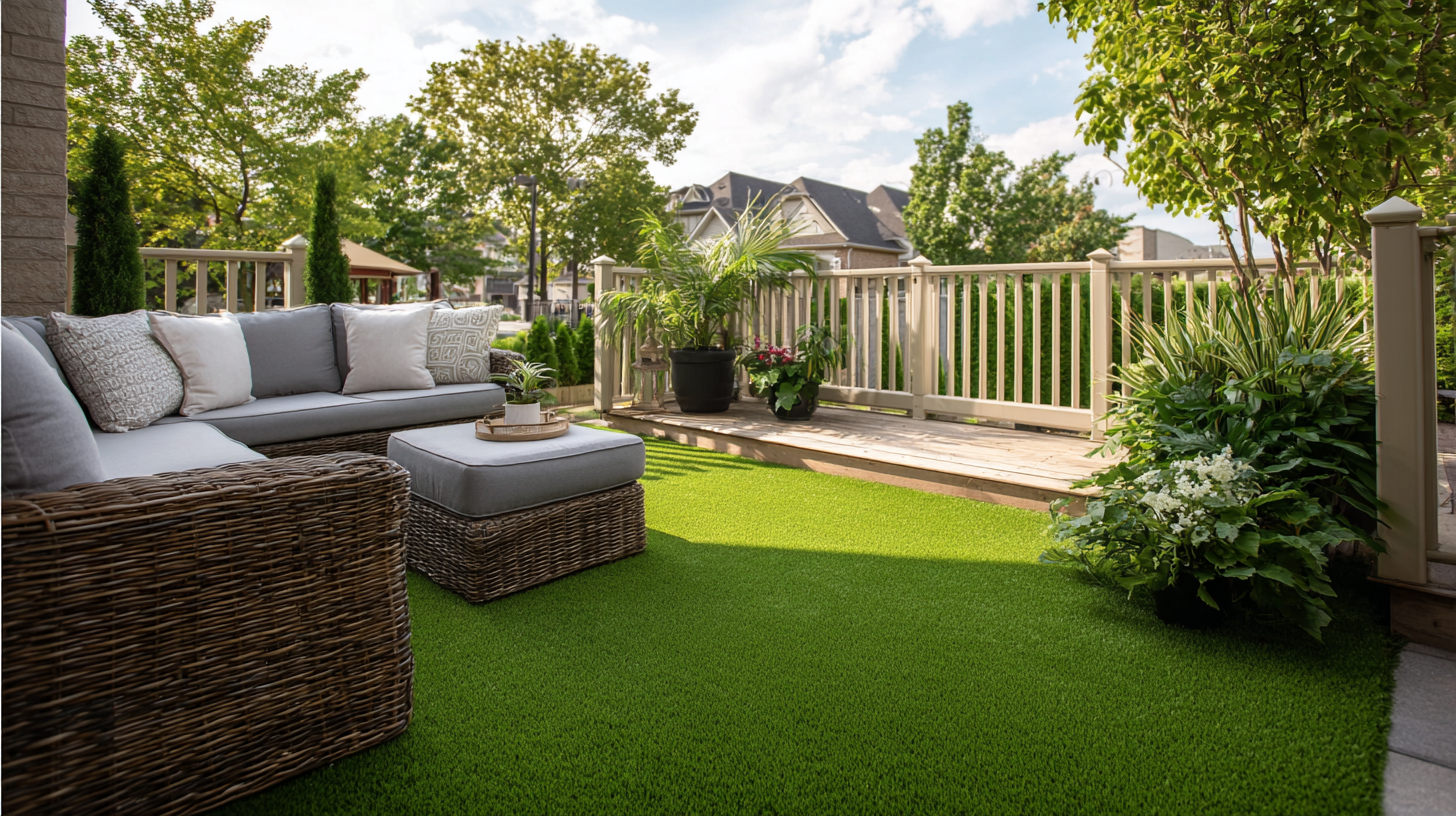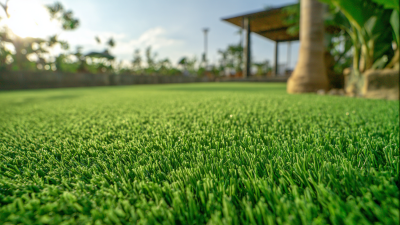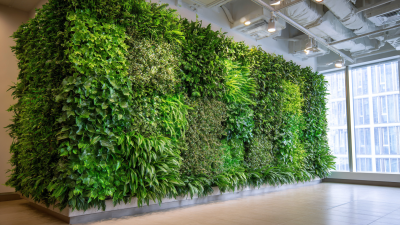When it comes to enhancing your outdoor spaces, the choice of ground covering is pivotal, and Outdoor Artificial Grass has emerged as a popular solution for many homeowners. According to a recent market report by Grand View Research, the artificial grass market is projected to reach $5.49 billion by 2027, growing at a CAGR of 9.6%. This rapid growth reflects an increasing awareness of the environmental benefits and maintenance advantages of synthetic lawns. Outdoor Artificial Grass not only offers a lush appearance year-round but also significantly reduces water consumption—potentially saving millions of gallons annually for average households. As more people shift towards sustainable landscaping options, understanding how to choose the best Outdoor Artificial Grass tailored to specific landscape needs becomes essential. This guide provides insights and tips on what to consider in your selection process, ensuring lasting beauty and functionality for your outdoor environment.

When selecting outdoor artificial grass, several key factors should be considered to ensure it meets your landscape needs. First and foremost, evaluate the intended use of the grass. For high-traffic areas such as play zones or dog runs, opt for a more durable product that can withstand wear and tear. Conversely, if the grass will adorn a decorative garden area, aesthetics may take precedence, allowing for softer and denser fibers that create a lush appearance.
Another important aspect is the pile height and face weight of the artificial grass. Taller blades can enhance the look and feel of a natural lawn, but they may require more maintenance to keep upright. Meanwhile, the face weight, measured in ounces per square yard, indicates the density and durability of the turf. A higher face weight often results in a more resilient surface, which can be vital for areas subject to heavy use. Additionally, consider the drainage capabilities and UV stability of the grass, as these factors significantly affect its longevity and performance in outdoor environments.
| Factor | Description | Considerations |
|---|---|---|
| Blade Height | The length of the grass blades, which affects the overall look and feel. | Choose based on the desired aesthetic; longer blades may look more natural. |
| Material | Type of material used in the grass, typically polyethylene, polypropylene, or nylon. | Consider durability and softness; nylon is tougher while polyethylene feels softer. |
| Drainage | The ability of the turf to allow water to flow through, reducing puddles. | Check for adequate drainage holes; ensures longevity and reduces odors. |
| Color Variations | Different shades of green and other colors available for a more realistic appearance. | Select colors that match natural grass in your area for a seamless look. |
| UV Stability | Resistance of the grass to fading from sun exposure. | Opt for UV-treated products for longevity in sunny environments. |
| Infill Type | Material placed between grass blades to provide stability and cushioning. | Consider crumb rubber or sand; each offers different benefits like shock absorption. |
| Maintenance Requirements | The level of care needed to keep the artificial grass in good condition. | Look for low-maintenance options to save time and effort. |
 When selecting artificial grass for outdoor landscapes, it's crucial to understand the different types of materials available. The most common materials are polyethylene, polypropylene, and nylon.
Polyethylene is known for its soft texture and durability, making it ideal for residential lawns and play areas. Its realistic appearance and resistance to fading ensure it retains its charm year-round, making it a popular choice among homeowners.
When selecting artificial grass for outdoor landscapes, it's crucial to understand the different types of materials available. The most common materials are polyethylene, polypropylene, and nylon.
Polyethylene is known for its soft texture and durability, making it ideal for residential lawns and play areas. Its realistic appearance and resistance to fading ensure it retains its charm year-round, making it a popular choice among homeowners.
On the other hand, polypropylene is a more cost-effective option. While it may not be as soft or durable as polyethylene, it is suitable for less trafficked areas such as decorative landscapes or temporary installations. For those seeking superior performance in high-traffic zones, nylon is unmatched. Although it comes with a higher price tag, its resilience and longevity make it worth the investment, especially for commercial areas or sports fields. Understanding these materials' unique properties will help you make an informed decision tailored to your landscape needs.
When selecting the best outdoor artificial grass for your landscape, evaluating the durability and maintenance requirements is crucial. Synthetic turf is designed to mimic natural grass, but not all products are created equal. Look for materials that withstand heavy foot traffic, UV exposure, and extreme weather conditions. High-quality synthetic grasses are crafted with robust backing systems and premium fibers that resist fading and wear over time, ensuring your lawn retains its aesthetic appeal without breaking down prematurely.
Maintenance is another key factor in your decision-making process. While artificial grass typically requires less upkeep than natural grass, some products demand more attention than others. Consider grasses that are easier to clean and have advanced drainage systems to prevent water pooling. Regular brushing, rinsing, and infrequent infill replenishment should be part of the maintenance routine. Opt for brands that specifically address ease of maintenance in their materials and provide clear care instructions, ensuring that your outdoor space remains vibrant with minimal effort.
This chart compares the durability and maintenance requirements of different types of outdoor artificial grass. The data reflects the average lifespan in years and the maintenance level required (on a scale from 1 to 5, with 1 being low maintenance and 5 being high maintenance).
When it comes to enhancing your outdoor space, selecting the right color and texture of artificial grass is crucial for achieving the desired aesthetic. A well-chosen hue can complement your existing landscape, creating a harmonious and inviting environment. For instance, a rich, emerald green can evoke the lushness of a natural lawn, making it ideal for gardens or family backyards.
 Conversely, lighter shades like olive or sage can blend seamlessly with a Mediterranean-style patio or a desert-themed landscape, providing a more understated, yet elegant charm.
Conversely, lighter shades like olive or sage can blend seamlessly with a Mediterranean-style patio or a desert-themed landscape, providing a more understated, yet elegant charm.
Texture is equally important in the selection process. The feel of the grass can dramatically influence the overall look and comfort of your outdoor area. For high-traffic zones, opting for a denser, more robust texture can ensure durability while maintaining a natural appearance. On the other hand, areas designated for relaxation or leisure can benefit from a softer, more luxurious texture that invites bare feet. Combining the right color palette with the perfect texture not only enhances the visual appeal but can also transform your outdoor spaces into serene retreats tailored to your lifestyle.
When considering outdoor artificial grass for your landscape, budgeting is a crucial step that shouldn’t be overlooked. The initial investment can vary significantly based on the quality of the grass and the size of your installation area. High-quality synthetic turf may come at a higher price, but it's often worth the cost due to its durability, lower maintenance requirements, and overall lifespan. Be sure to research different brands and synthetic grass options to find the balance between quality and affordability that suits your needs.
In addition to the upfront costs, it's essential to account for the ongoing maintenance expenses. Although artificial grass requires less upkeep than natural grass, there are still associated costs, such as occasional cleaning, infill replacement, and potential repairs. Setting aside a budget for these expenses will help ensure that your outdoor space remains lush and attractive for years to come. By carefully planning your budget, you’ll not only enhance your landscape but also enjoy the peace of mind that comes with a well-maintained outdoor environment.












